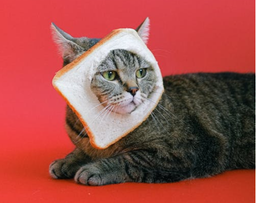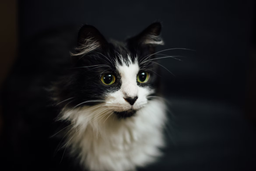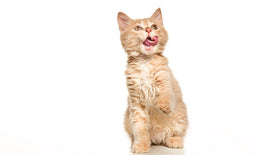A natural remedy or an aggressive stimulant—can cats eat catnip?
There are numerous photos and videos of cats acting all bizarre under the influence of catnip. Some get a pleasant buzz and take a long nap, and others parade around like hyperspace cadets on a mission. While the effects of this plant on felines are fun to watch, the question remains: Can cats eat catnip and stay unscathed, or does it turn them into junkies and ruin their health?
Catnip is essentially an olfactory delight for cats, meaning it teases their sense of smell and triggers a physiological reaction beyond their control. It’s not real cat food or a snack but a stimulant setting off various reactions. Some cat parents also use it to regulate or stimulate their kitty’s behaviour. Before introducing your cat to this perennial herb, it’s imperative to understand:
- What catnip does to cats if they eat or inhale it
- Whether it can cause an adverse reaction
- What precautions you should take while serving it
- How often your kitty can indulge in a catnip trip
Why do cats eat or inhale catnip?
A cat’s natural diet includes fresh kill or raw and cooked meat if they live indoors. So, how does an obscure plant entice an obligate carnivore?
Catnip comes from the same family of herbs like mint, oregano, and sage. It contains the aromatic chemical compound nepetalactone, which acts as a defensive pest-repellent for the plant and is also responsible for attracting cats like moths to a flame! According to studies based on a series of situational experiments on domestic cats, nepetalactone possibly replicates the effect of mood-elevating feline pheromones that affect courtship and mating behaviour in cats.
Being a psychoactive compound, nepetalactone may trigger the following instinctive behavioural patterns:
- Inhaling—Because of their heightened sense of smell, cats quickly detect the active nepetalactone in catnip, and inhaling it is their most common response
- Licking, chewing, and ingesting—Many hyped cats tend to indulge in a mouthful of catnip after snorting it because they want to prolong the initial state of euphoria
- Rubbing and rolling—Some cats rub catnip against their fur and skin before rolling around on the floor, which is a typical mating behaviour in intact felines

What’s that bewitching smell, and why do I feel the sudden urge to frolic about like a hedonistic goofball?
Source: Gaia Metal Studio
What happens to cats when they eat catnip? Is it different from inhaling it?
While inhaling or ingesting catnip activates the happiness centre in your kitty’s brain, these consumption methods provoke opposite physical reactions in cats. The table below outlines what happens in each case:
|
Aspect |
Cat inhaling catnip |
Cat eating catnip |
|
Reaction |
Causes hyperactivity like running, jumping, meowing, or behaving wildly (read: getting the zoomies), followed by passing out from over-exertion |
Has a mellowing effect on cats and can act as a mild sedative, leading to relaxing, drooling, light purring, and dozing off |
|
Kick-in time |
About 5–15 minutes |
May take longer to kick in |
|
Wear-off time |
Within 30 minutes |
An hour or two (the duration of the calming effect varies depending on the cat) |
Catnip is not addictive. While it is generally safe for cats, you should adjust the dosage based on whether you’re using fresh or dry plants.
Can cats eat dried catnip plants?
Catnip is widely available as loose or powdered dried leaves. You can sprinkle it on your cat’s bed, toys, or playing area, but it is up to them whether they lick or inhale it. If your kitty tends to eat dried catnip, keep the dosage between one teaspoon to one tablespoon, depending on their weight. Large breeds like Ragdolls, Bengals, and Maine Coons may consume catnip in larger amounts to experience its effects.
Is fresh catnip safe for cats?
Yes, cats can safely eat fresh catnip, albeit in small amounts, as it is more potent than the dried variant. When chewed fresh, catnip releases nepetalactone directly in your cat’s mouth. Felines have a smell receptor called the vomeronasal gland on the roof of their mouth, sending direct signals to the brain upon detecting nepetalactone, allowing the effect to kick in faster.
Is it safe for cats to eat catnip leaves?
Fresh catnip leaves and stems are rich in nepetalactone, so your kitty shouldn't eat more than 10–20 grams.

This smells better than you, hooman. If you want cuddles, now is not the time.
Source: ilovebutter
Can cats eat catnip flowers?
When approaching a catnip plant, your kitty may first nibble on the flowers as they overflow with nepetalactone, often more than the leaves. The nepetalactone levels drop as flowers start seeding, so most cats don’t care much about catnip seeds. With high concentrations of nepetalactone, owners should be careful that their cats don’t eat too many catnip flowers.
Is it bad for pregnant cats to eat catnip?
Catnip is a uterus stimulant, so you shouldn't give it to a pregnant cat as it may induce premature labour. It can also affect the placenta and compromise the health of her litter.
What happens when desexed cats eat or inhale catnip?
The reaction to catnip may mimic feline mating behaviour, but the plant also works on spayed or neutered cats (as it’s essentially a neural response to a psychoactive chemical). Intact felines tend to react more aggressively to inhaling catnip as they have relatively higher energy levels than desexed cats. Hyperactive cats may also injure themselves due to uncontrolled movements provoked by the influence of the plant.
Is it okay for intact cats to eat catnip?
Since eating catnip can pacify cats, it may help calm down hyperactive intact felines for a little while. It’s not a long-term solution because regular consumption can lead to increased catnip tolerance, making cats immune to it.
When can I give my kitten catnip?
If you want your kitten to enjoy the herb’s olfactory stimulation, you’ll have to wait till they’re old enough.
Kittens have underdeveloped sensory receptors for the first six months of their life, so inhaling the herb would have little to no impact on them. In a study conducted on 60 shelter cats in Mexico, 45% of adult cats had a reaction to catnip, compared to only 25% of juvenile kittens (3–6 months). Young kittens (0–3 months) had no reaction to catnip exposure.
Can kittens eat catnip?
Ingesting a tiny portion of catnip wouldn’t usually harm a kitten, but it’s better to hold off the treat till they’re adults and have gained healthy weight. Raw or dried catnip leaves contain cellulose, which is indigestible to cats.
While older kittens may handle eating the herb, it can be a major stomach irritant for those who have recently started eating solids. Many younglings end up with a nasty bout of diarrhoea or vomiting after chewing a few catnip leaves, so it’s not worth the risk.
My cat ate catnip, and nothing happened…why?
Sensitivity to catnip is a genetic trait, and only about two-thirds of cats have the gene making them susceptible to the plant. If your kitty ate catnip and experienced nothing, they are probably immune to nepetalactone.
Can cats eat too much catnip?
Yes, eating catnip excessively can be detrimental to your cat’s health because it’s ultimately a plant. A cat's digestive system is designed to process meat, and they don’t have enough enzymes to break down too much plant matter at a time.
Chewing too many catnip leaves or flowers can cause indigestion and make cats sick. As for cats with sensitive stomachs, even a dash of fresh catnip treat can lead to constipation or diarrhoea.
A tiny percentage of cats may also be allergic to the plant. Steer clear of catnip if your cat displays the following symptoms upon exposure:
- Tummy ache
- Gastrointestinal problems
- Sneezing and wheezing
- Excessive shedding
- Red, itchy eyes
- Inflamed skin
- Loss of appetite

Coked or conked out—Kitty life is stressful, and ’nipping is my way to cope. But maybe I had a bit too much today, or did the world indeed turn upside down?
Source: Marcus Ward
Are there any health benefits to cats eating catnip?
When it comes to health benefits, catnip does not excel. Eating the herb may release some happy hormones and calm down anxiety-prone or hyperactive cats (like Siamese) for a couple of hours, but that’s that. It’s edible but holds no nutritional value for felines.
Many cat parents use it as a behaviour regulator, pain suppressor, or remedy for hairballs, but can catnip help resolve these issues?
Is catnip an effective behaviour regulation tool?
Let’s check out how cat parents use catnip to regulate feline behaviour:
- Improving trainability—Some cat parents give their cats catnip as a reward for adhering to training commands
- Reducing lethargy or inactivity—Since inhaling catnip causes a momentary burst of energy, many use it to stimulate overweight cats, especially laid-back breeds like British Shorthairs and Persians. Unfortunately, catnip has no significant long-term impact on weight control or energy levels. Felines need a high-protein, low-fat, and low-carb diet to stay in shape and get enough calories to power through the day
- Controlling hyperactive cats—Inhaling catnip can help hyperactive cats release their pent-up energy and tire themselves enough to sleep, but eating it may directly send them to snoozeville. Keep in mind that hyperactivity in cats is often associated with hormonal disorders, like hyperthyroidism, which can only be regulated with medicines and a healthy diet
- Optimising sleeping habits—Catnip is ideal for regulating your kitty’s sleeping schedule, but avoid feeding them dried or fresh leaves regularly as they overstress their stomach. Here are some alternatives you can try:
Remember that nepetalactone has a temporary effect on felines susceptible to it. It doesn’t address the reason behind their odd behaviour, which is often an inadequate diet or underlying medical condition.
Can catnip help with pain?
Cat parents use catnip’s numbing effect for pain management in cats, especially seniors. While the plant can act as an analgesic and muscle-relaxant for mild discomfort after dental extractions, it doesn’t help much with painful conditions like IBS, cystitis, and bladder stones.

Immunity flex—I smell nothing. I don’t fancy eating them. Hairballs won’t go away unless you put top protein in my meal plan, hooman.
Source: chilligram.c
Should cats eat catnip to prevent or reduce hairballs?
Catnip is not a solution per se but a physical stimulant for expelling undigested food or hairballs. Since the plant has a low digestive value for felines, ingesting it can help them cough up hairballs and prevent intestinal blockages. Cats need animal proteins and fats in their meals to strengthen their coat, which automatically minimises the hairball problem.
Catnip won’t fix any problems, but the proper diet will
Catnip may stabilise your cat’s mood or behaviour, but you cannot use it to solve problems stemming from an imbalanced diet. Without the right meal plan, your feline may experience health setbacks due to:
- Lack of quality proteins—A cat’s diet should contain 50% or more protein from whole meat. Low-quality proteins include over-processed meat and animal derivatives, legumes, eggs, and dairy, which are hard to digest. Lack of animal protein can lead to eating disorders like overeating or the loss of appetite, also causing muscle loss and anorexia in extreme cases
- Vitamin and mineral deficiency—Felines need the vitamins and minerals derived from meat to regulate various life processes. Deficiency of these micronutrients could lead to poor joint and dental health, inability to absorb essential nutrients, lethargy, etc.
- Carb overdose—Many cat food products are loaded with carbs like grain, sugar, and starch. They increase the volume of food without adding any nutritional value to it. Since cats have practically no use of carbs in their diet, overconsumption can lead to feline diabetes and obesity
I want to improve my kitty’s mood and behaviour through food—how do I do that?
If you want your cat to have even energy levels and a happy disposition, feed them grain-free wet food with real meat, organs, fish, or crustaceans. While dry and semi-moist products are cheap, they are also heavily processed and often come loaded with carbs and fats. If you are on a budget, give your cat a combination of dry and wet meals.

Catnip fades like a happy dream, but the power of wholesome food lingers. Untamed supports your kitty through thick and thin.
Image (c) Untamed
Want to surprise your cat with nutritious delights? Try Untamed wet food!
Catnip may or may not loosen up your kitty on rough days, but if you want a reliable solution for overall feline welfare, choose Untamed! We offer wet food with over 60% whole meat and organs, containing twice more proteins than the industry average. We gently steam our food in gravy or jelly to ensure cats get a kick of taste, aroma, and nutrition in every bite!
Untamed is the best you can get for your furry companion because we:
- Offer balanced meals—We use vet-designed formulas to make our food complete and balanced without sacrificing the taste. Our recipes also offer antioxidants like taurine and vitamin E to help cats develop a strong immune system
- Use quality ingredients—We only use prime cuts of highly digestible and fresh human-grade whole meat, avoiding coarse fillers like grains, sugar, vegetables, and meat derivatives that can corrupt the feline digestive system
- Provide allergen-free meals—We don’t use harsh artificial preservatives and chemical taste enhancers. All our products are free from known allergens, making them ideal for felines struggling with sensitivities or allergies
- Are fussy-cat-approved—We fine-tuned our recipes to the taste preferences of different cats and have something for every furry diva. We offer several yummy protein options, like chicken breast and liver, tuna, ham, duck, salmon, shrimp, mackerel, and sardine
Take our TRY NOW quiz if you want a tailor-made meal plan fitted to your kitty’s taste preferences, food sensitivities, allergies, and life stage—we will also send you your first Untamed taster pack at the best rate!
Why look for a temporary high when Untamed offers lifelong happiness?
Nothing can replace quality meat in your cat’s meals. Untamed isn’t a temporary fix but a lifelong benefit for your cat. Our food works for all ages and breeds and helps prevent common feline diseases like diabetes and arthritis. If you have a frail senior cat with a poor appetite, our light and delicious food can help them regain healthy weight.

We only choose the best for our meals. Get your cat hooked on the right food with Untamed!
Image (c) Untamed
In case you’re dealing with a kibble-obsessed cat who refuses to touch wet food, introduce them to our tempting flavours and watch the magic happen!
Untamed has changed the life of many kitties. Here's how happy cat parents describe the Untamed effect:
|
Timeline |
Benefits |
|
One week |
|
|
Two to four months |
|
|
Six months and up |
|
No dealers or go-betweens—we’ll deliver to your doorstep
Buying Untamed is a straightforward process thanks to our smooth online ordering system for cat food. Here’s what you need to do to get your taster pack:
- Complete the TRY NOW quiz
- Review the meal plan
- Place the order
We will deliver it within a day. Your kitty can sample different meals over the week. If they want more, we can send you monthly Untamed supplies with free shipping. The cat food subscription is 100% under your control—you can modify, skip, postpone, or cancel an order anytime.
We believe in ethical cat food production and keeping our carbon footprint neutral. Our ingredients come from cruelty-free and sustainable sources, and our packaging is completely recyclable.
Untamed cans have a three-year shelf life and require no heating or freezing. You can stash them up for emergencies—the irresistible aroma of our food will brighten up your kitty’s day whenever you open a can!

Happy today, tomorrow, and forever—kitties on Untamed live their best lives (without external stimulants)!
Image (c) Untamed
The final word on catnip
If catnip affects your cat, there is no harm in letting them revel in the non-addictive bliss occasionally. Ensure you supervise their catnip trip to prevent accidental injuries. Avoid over-exposing your cat to the fancy herb if you don’t want them to develop catnip resistance.
Remember that the stimulating plant is not a snack. If you think your hungry kitty needs a treat, consider the following options:
|
Snack type |
Options |
Ensure these treats are contaminant-free |
|
|
Moisture-rich treats |
|
|
Human snacks |
Avoid giving potentially harmful feline food to your cat—for example, grapes, allium veggies, green tomatoes, wild mushrooms, chocolates, peanut butter, and coconut oil.
Check out our other guides to what cats can or cannot eat:
|
|

![Best food for Ragdoll cats in the UK [Broken Down]](http://untamed.com/cdn/shop/articles/featured_best_food_for_ragdoll_cats_uk.jpg?v=1646818249&width=256)

